Introduction to Matlab.pdf
- 1. Introduction to MATLAB Introduction to MATLAB Introduction to Matlab 1
- 2. Introduction to MATLAB Introduction to MATLAB Outline: Outline: â° What is Matlab? â° What is Matlab? â Matlab Screen V i bl t i i d i â Variables, array, matrix, indexing â Operators (Arithmetic, relational, logical ) â Display Facilities â Flow Control Flow Control â Using of M-File â Writing User Defined Functions â Writing User Defined Functions â Conclusion 2
- 3. Introduction to MATLAB Introduction to MATLAB What is Matlab? What is Matlab? â Matlab is basically a high level language y g g g which has many specialized toolboxes for making things easier for us making things easier for us â How high? M l b Matlab High Level Languages such as g g C, Pascal etc. Assembly 3
- 4. Introduction to MATLAB Introduction to MATLAB What are we interested in? What are we interested in? â Matlab is too broad for our purposes in this â Matlab is too broad for our purposes in this course. â The features we are going to require is Matlab Matlab Series of Matlab d Command Line m-files mat-files commands functions Command execution like DOS command Input Data storage/ like DOS command window p Output capability storage/ loading 4
- 5. Introduction to MATLAB Introduction to MATLAB Matlab Screen Matlab Screen Command Window â Command Window â° type commands â Current Directory â° View folders and m-files â Workspace â° View program variables â° Double click on a variable to see it in the Array Editor â Command History â° view past commands â° save a whole session â° save a whole session using diary 5
- 6. Introduction to MATLAB Introduction to MATLAB Variables Variables â No need for types i e â No need for types. i.e., int a; int a; double b; float c; â All variables are created with double precision unless specified and they are matrices. p y Example: >>x=5; Aft th t t t th i bl 1 1 t i >>x=5; >>x1=2; â After these statements, the variables are 1x1 matrices with double precision 6
- 7. Introduction to MATLAB Introduction to MATLAB Array Matrix Array, Matrix t â a vector x = [1 2 5 1] x = 1 2 5 1 1 2 5 1 â a matrix x = [1 2 3; 5 1 4; 3 2 -1] x = 1 2 3 5 1 4 5 1 4 3 2 -1 â transpose y xâ y â transpose y = xâ y = 1 2 5 5 1 7
- 8. Introduction to MATLAB Introduction to MATLAB Long Array Matrix Long Array, Matrix â t =1:10 t = t 1 2 3 4 5 6 7 8 9 10 â k =2:-0.5:-1 k = 2 1 5 1 0 5 0 -0 5 -1 2 1.5 1 0.5 0 0.5 1 â B = [1:4; 5:8] x = 1 2 3 4 1 2 3 4 5 6 7 8 8
- 9. Introduction to MATLAB Introduction to MATLAB Generating Vectors from functions Generating Vectors from functions â zeros(M,N) MxN matrix of zeros x = zeros(1 3) ( , ) x = zeros(1,3) x = 0 0 0 â ones(M,N) MxN matrix of ones 0 0 0 (1 3) x = ones(1,3) x = â rand(M,N) MxN matrix of uniformly di t ib t d d 1 1 1 distributed random numbers on (0,1) x = rand(1,3) x = 0.9501 0.2311 0.6068 9
- 10. Introduction to MATLAB Introduction to MATLAB Matrix Index Matrix Index Th t i i di b i f 1 ( t 0 ( i C)) â The matrix indices begin from 1 (not 0 (as in C)) â The matrix indices must be positive integer Given: Given: A(-2) A(0) A( 2), A(0) Error: ??? Subscript indices must either be real positive integers or logicals. A(4,2) Error: ??? Index exceeds matrix dimensions. 10
- 11. Introduction to MATLAB Introduction to MATLAB Concatenation of Matrices Concatenation of Matrices â x = [1 2], y = [4 5], z=[ 0 0] A = [ x y] A = [ x y] 1 2 4 5 B = [x ; y] 1 2 4 5 4 5 C = [x y ;z] C [x y ;z] Error: ??? Error using ==> vertcat CAT arguments dimensions are not consistent. 11
- 12. Introduction to MATLAB Introduction to MATLAB Operators (arithmetic) Operators (arithmetic) + addition + addition - subtraction * multiplication / division ^ power power â complex conjugate transpose 12
- 13. Introduction to MATLAB Introduction to MATLAB Matrices Operations Matrices Operations Given A and B: Addition Subtraction Product Transpose 13
- 14. Introduction to MATLAB Introduction to MATLAB Operators (Element by Element) Operators (Element by Element) .* element-by-element multiplication ./ element-by-element division ^ element-by-element power . element-by-element power 14
- 15. Introduction to MATLAB Introduction to MATLAB The use of â â â âElementâ Operation The use of . Element Operation A = [1 2 3; 5 1 4; 3 2 1] A A = 1 2 3 5 1 4 3 2 -1 b x * y c x / y d x ^2 y = A(3 ,:) b = x .* y b= c = x . / y c= d = x .^2 d= x = A(1,:) K ^2 y= 3 4 -1 3 8 -3 0.33 0.5 -3 1 4 9 x= 1 2 3 K= x^2 Erorr: ??? Error using ==> mpower Matrix must be square. B=x*y Erorr: ??? Error using ==> mtimes Inner matrix dimensions must agree. g g 15
- 16. Introduction to MATLAB Introduction to MATLAB Basic Task: Plot the function sin(x) Basic Task: Plot the function sin(x) between 0âĪxâĪ4Ï â Create an x-array of 100 samples between 0 and 4Ï. and 4Ï. â Calculate sin(.) of the x-array >>x=linspace(0,4*pi,100); Calculate sin(.) of the x array >> i ( ) 0 4 0.6 0.8 1 â Plot the y-array >>y=sin(x); -0.2 0 0.2 0.4 y y >>plot(y) 0 10 20 30 40 50 60 70 80 90 100 -1 -0.8 -0.6 -0.4 0 10 20 30 40 50 60 70 80 90 100 16
- 17. Introduction to MATLAB Introduction to MATLAB Plot the function e-x/3sin(x) between Plot the function e sin(x) between 0âĪxâĪ4Ï â Create an x-array of 100 samples between 0 and 4Ï and 4Ï. >>x=linspace(0,4*pi,100); â Calculate sin(.) of the x-array â Calculate e-x/3 of the x-array >>y=sin(x); â Calculate e of the x array >>y1=exp(-x/3); â Multiply the arrays y and y1 >> 2 * 1 >>y2=y*y1; 17
- 18. Introduction to MATLAB Introduction to MATLAB Plot the function e-x/3sin(x) between Plot the function e sin(x) between 0âĪxâĪ4Ï â Multiply the arrays y and y1 correctly â Plot the y2-array >>y2=y.*y1; â Plot the y2 array >>plot(y2) 0.6 0.7 p (y ) 0.3 0.4 0.5 0 0.1 0.2 0 10 20 30 40 50 60 70 80 90 100 -0.3 -0.2 -0.1 18
- 19. Introduction to MATLAB Introduction to MATLAB Display Facilities Display Facilities l t( ) 0.5 0.6 0.7 â plot(.) Example: 0.2 0.3 0.4 Example: >>x=linspace(0,4*pi,100); >>y=sin(x); >>plot(y) 0 2 -0.1 0 0.1 stem( ) >>plot(y) >>plot(x,y) 0.7 0 10 20 30 40 50 60 70 80 90 100 -0.3 -0.2 â stem(.) 0 3 0.4 0.5 0.6 Example: >>stem(y) 0 0.1 0.2 0.3 >>stem(x,y) 0 10 20 30 40 50 60 70 80 90 100 -0.3 -0.2 -0.1 19
- 20. Introduction to MATLAB Introduction to MATLAB Display Facilities Display Facilities â title(.) â xlabel( ) >>title(âThis is the sinus functionâ) 0.6 0.8 1 This is the sinus function â xlabel(.) >>xlabel(âx (secs)â) 0 0.2 0.4 0.6 n(x) â ylabel(.) -0.6 -0.4 -0.2 0 sin >>ylabel(âsin(x)â) 0 10 20 30 40 50 60 70 80 90 100 -1 -0.8 0.6 x (secs) ( ) 20
- 21. Introduction to MATLAB Introduction to MATLAB Operators (relational logical) Operators (relational, logical) â == Equal to â ~= Not equal to â < Strictly smaller â < Strictly smaller â > Strictly greater â <= Smaller than or equal to >= Greater than equal to â >= Greater than equal to â & And operator p â | Or operator 21
- 22. Introduction to MATLAB Introduction to MATLAB Flow Control Flow Control â if â for â while â while â break â âĶ. 22
- 23. Introduction to MATLAB Introduction to MATLAB Control Structures Control Structures Some Dummy Examples â If Statement Syntax Some Dummy Examples if ((a>3) & (b==5)) if (Condition_1) Matlab Commands Some Matlab Commands; end Matlab Commands elseif (Condition_2) Matlab Commands if (a<3) Some Matlab Commands; elseif (b~=5) Matlab Commands elseif (Condition_3) Matlab Commands elseif (b 5) Some Matlab Commands; end Matlab Commands else Matlab Commands if (a<3) Some Matlab Commands; l Matlab Commands end else Some Matlab Commands; end 23
- 24. Introduction to MATLAB Introduction to MATLAB Control Structures Control Structures Some Dummy Examples â For loop syntax Some Dummy Examples for i=1:100 S M tl b C d for i=Index Array Some Matlab Commands; end for i=Index_Array Matlab Commands for j=1:3:200 Some Matlab Commands; end end for m=13:-0.2:-21 Some Matlab Commands; Some Matlab Commands; end for k [0 1 0 3 13 12 7 9 3] for k=[0.1 0.3 -13 12 7 -9.3] Some Matlab Commands; end 24
- 25. Introduction to MATLAB Introduction to MATLAB Control Structures Control Structures â While Loop Syntax while (condition) Dummy Example while (condition) Matlab Commands while ((a>3) & (b==5)) Some Matlab Commands; end Some Matlab Commands; end 25
- 26. Use of M-File Use of M File Click to create Click to create a new M-File âĒ Extension â.mâ âĒ A text file containing script or function or program to run 26
- 27. Introduction to MATLAB Introduction to MATLAB Use of M-File Use of M File Save file as Denem430.m If you include â;â at the If you include ; at the end of each statement, result will not be shown immediately immediately 27
- 28. Introduction to MATLAB Introduction to MATLAB File Input Statements p â Clear memory â Clear screen â fid = fopen(filename) â fid = fopen(filename, permission) } Argument fid is a file identifier associated p ( , p ) â StatementsâĶ.. â { âĶâĶ } Here opens the file filename for read with an open file â A = fscanf(fid, format) filename for read access reads data from the file specified by fid converts it specified by fid, converts it according to the specified format string, and returns it in matrix A â fclose(fid) 28
- 29. Introduction to MATLAB Introduction to MATLAB File Output Statements Here opens the file â count = fprintf(fid, format, A, ...) p p filename for write access formats the data in the real part of matrix A A conversion specification controls the notation, alignment, significant di it fi ld idth d digits, field width, and other aspects of output format. 29
- 30. Introduction to MATLAB Introduction to MATLAB File Output Statements p 30
- 31. Introduction to MATLAB Introduction to MATLAB File Output Statements p 31
- 32. Introduction to MATLAB Introduction to MATLAB File Output Statements p 32
- 33. Introduction to MATLAB Introduction to MATLAB Writing User Defined Functions Writing User Defined Functions â Functions are m-files which can be executed by specifying some inputs and supply some desired outputs. â The code telling the Matlab that an m-file is actually a function is function out1=functionname(in1) function out1=functionname(in1,in2,in3) ( , , ) function [out1,out2]=functionname(in1,in2) â You should write this command at the beginning of the m-file and you should save the m-file with a file name m-file and you should save the m-file with a file name same as the function name 33
- 34. Introduction to MATLAB Introduction to MATLAB Writing User Defined Functions g â Examples p â° Write a function : out=squarer (A, ind) â Which takes the square of the input matrix if the input q p p indicator is equal to 1 â And takes the element by element square of the input t i if th i t i di t i l t 2 matrix if the input indicator is equal to 2 Same Name 34
- 35. Introduction to MATLAB Introduction to MATLAB Writing User Defined Functions Writing User Defined Functions â Another function which takes an input array and returns the sum and product of its elements as outputs â The function sumprod(.) can be called from command window or an m-file as 35
- 36. Introduction to MATLAB Introduction to MATLAB Notes: Notes: â â%â is the neglect sign for Matlab (equaivalent â % is the neglect sign for Matlab (equaivalent of â//â in C). Anything after it on the same line is neglected by Matlab compiler is neglected by Matlab compiler. â Sometimes slowing down the execution is g done deliberately for observation purposes. You can use the command âpauseâ for this You can use the command pause for this purpose pause %wait until any key pause(3) %wait 3 seconds pause(3) %wait 3 seconds 36
- 37. Introduction to MATLAB Introduction to MATLAB Useful Commands Useful Commands â The two commands used most by Matlab â The two commands used most by Matlab users are >>help functionname >>lookfor keyword 37
- 38. Introduction to MATLAB Introduction to MATLAB Th k Y Thank YouâĶ 38
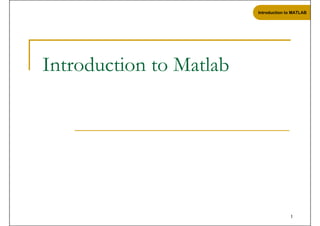
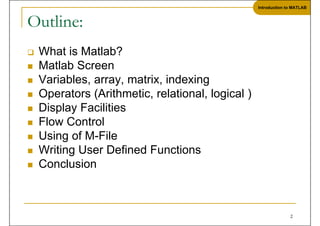
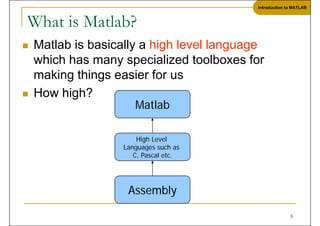
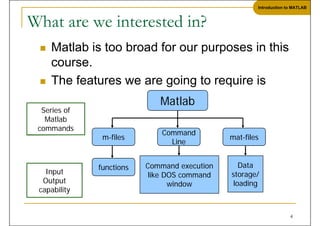
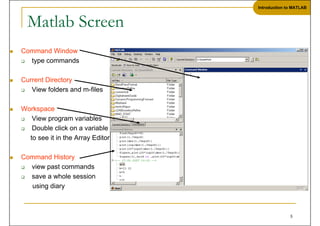
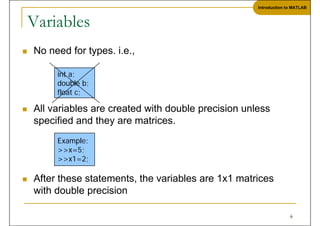
![Introduction to MATLAB
Introduction to MATLAB
Array Matrix
Array, Matrix
t
â a vector x = [1 2 5 1]
x =
1 2 5 1
1 2 5 1
â a matrix x = [1 2 3; 5 1 4; 3 2 -1]
x =
1 2 3
5 1 4
5 1 4
3 2 -1
â transpose y xâ y
â transpose y = xâ y =
1
2
5
5
1
7](https://image.slidesharecdn.com/introductiontomatlab-221008074910-450469ac/85/Introduction-to-Matlab-pdf-7-320.jpg)
![Introduction to MATLAB
Introduction to MATLAB
Long Array Matrix
Long Array, Matrix
â t =1:10
t =
t
1 2 3 4 5 6 7 8 9 10
â k =2:-0.5:-1
k =
2 1 5 1 0 5 0 -0 5 -1
2 1.5 1 0.5 0 0.5 1
â B = [1:4; 5:8]
x =
1 2 3 4
1 2 3 4
5 6 7 8
8](https://image.slidesharecdn.com/introductiontomatlab-221008074910-450469ac/85/Introduction-to-Matlab-pdf-8-320.jpg)
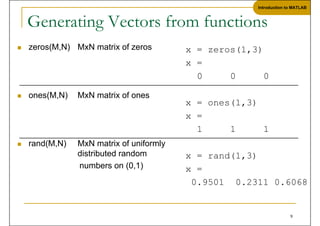

![Introduction to MATLAB
Introduction to MATLAB
Concatenation of Matrices
Concatenation of Matrices
â x = [1 2], y = [4 5], z=[ 0 0]
A = [ x y]
A = [ x y]
1 2 4 5
B = [x ; y]
1 2
4 5
4 5
C = [x y ;z]
C [x y ;z]
Error:
??? Error using ==> vertcat CAT arguments dimensions are not consistent.
11](https://image.slidesharecdn.com/introductiontomatlab-221008074910-450469ac/85/Introduction-to-Matlab-pdf-11-320.jpg)

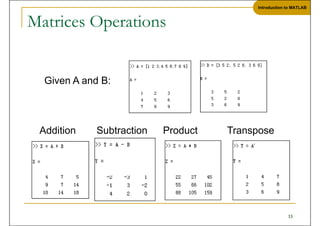
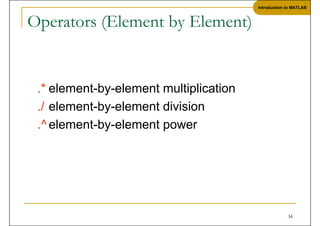
![Introduction to MATLAB
Introduction to MATLAB
The use of â â â âElementâ Operation
The use of . Element Operation
A = [1 2 3; 5 1 4; 3 2 1]
A
A =
1 2 3
5 1 4
3 2 -1
b x * y c x / y d x ^2
y = A(3 ,:)
b = x .* y
b=
c = x . / y
c=
d = x .^2
d=
x = A(1,:)
K ^2
y=
3 4 -1
3 8 -3 0.33 0.5 -3 1 4 9
x=
1 2 3
K= x^2
Erorr:
??? Error using ==> mpower Matrix must be square.
B=x*y
Erorr:
??? Error using ==> mtimes Inner matrix dimensions must agree.
g g
15](https://image.slidesharecdn.com/introductiontomatlab-221008074910-450469ac/85/Introduction-to-Matlab-pdf-15-320.jpg)


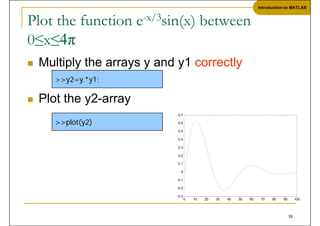





![Introduction to MATLAB
Introduction to MATLAB
Control Structures
Control Structures
Some Dummy Examples
â For loop syntax
Some Dummy Examples
for i=1:100
S M tl b C d
for i=Index Array
Some Matlab Commands;
end
for i=Index_Array
Matlab Commands
for j=1:3:200
Some Matlab Commands;
end
end for m=13:-0.2:-21
Some Matlab Commands;
Some Matlab Commands;
end
for k [0 1 0 3 13 12 7 9 3]
for k=[0.1 0.3 -13 12 7 -9.3]
Some Matlab Commands;
end
24](https://image.slidesharecdn.com/introductiontomatlab-221008074910-450469ac/85/Introduction-to-Matlab-pdf-24-320.jpg)








![Introduction to MATLAB
Introduction to MATLAB
Writing User Defined Functions
Writing User Defined Functions
â Functions are m-files which can be executed by
specifying some inputs and supply some desired outputs.
â The code telling the Matlab that an m-file is actually a
function is
function out1=functionname(in1)
function out1=functionname(in1,in2,in3)
( , , )
function [out1,out2]=functionname(in1,in2)
â You should write this command at the beginning of the
m-file and you should save the m-file with a file name
m-file and you should save the m-file with a file name
same as the function name
33](https://image.slidesharecdn.com/introductiontomatlab-221008074910-450469ac/85/Introduction-to-Matlab-pdf-33-320.jpg)





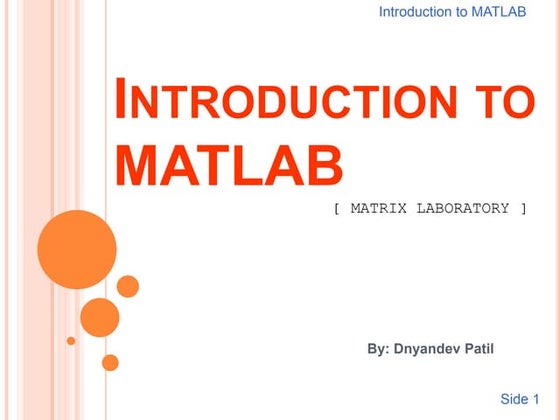










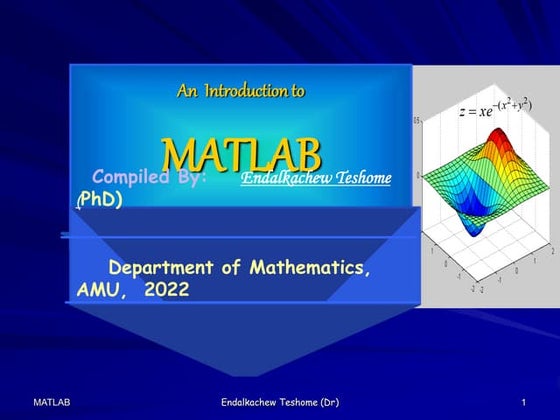


































![Fast Screen Recorder v2.1.0.11 Crack Updated [April-2025]](https://cdn.slidesharecdn.com/ss_thumbnails/dataanalysisforbusiness-250322061148-eeff8a831-250401123246-f36be9ca-250401141614-87b01766-thumbnail.jpg?width=560&fit=bounds)
